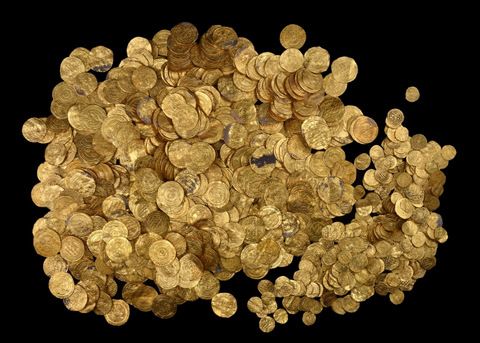CoinWorld.com | By Joe O’Donnell, Coin World | February 17, 2015

Nearly 2,000 coins from the 11th century found by a diving club
The largest hoard of gold coins ever discovered in Israel was found in recent weeks on the seabed in the ancient harbor in Caesarea National Park by a group of divers from a local diving club, according to a release from the Israel Antiquities Authority.
In all, almost 2,000 gold coins from the 11th century Fatimid period were discovered.
The coins carried dinar, half dinar, and quarter dinar denominations, and had various dimensions and weight. “The coins are in an excellent state of preservation,” IAA numismatic expert Robert Cole said, “and despite the fact they were at the bottom of the sea for about a thousand years, they did not require any cleaning or conservation intervention from the metallurgical laboratory.”
LATEST: Who does the gold-coin hoard found in Israel belong to?
The divers at first they thought they had spotted a toy coin from a game. It was only after they understood the coin was real that they collected several and returned to the shore to inform the director of the dive club about their find. The Marine Archaeology Unit of the IAA was then notified, and after quickly organizing, divers of the IAA went together with members of the diving club to where the coins were found and unearthed the rest using a metal detector.
“The discovery of such a large hoard of coins that had such tremendous economic power in antiquity raises several possibilities regarding its presence on the seabed,” Kobi Sharvit, director of the IAA Marine Archaeology Unit, said. “There is probably a shipwreck there of an official treasury boat which was on its way to the central government in Egypt with taxes that had been collected.”
VIDEO: Recovery of underwater hoard of gold coins in Israel filmed
(telegraph.co.uk | By Charlotte Kro, and Reuters, video source ITN)
Cole said several of the coins that were found in the assemblage were bent and exhibit teeth and bite marks, evidence they were physically inspected by their owners or the merchants. Other coins bear signs of wear and abrasion from use while others seem as though they were just minted.
The Caesarea Development Company and Nature and Parks Authority said in a statement, “There is no doubt that the discovery of the impressive treasure highlights the uniqueness of Caesarea as an ancient port city with rich history and cultural heritage. After 2,000 years it is still capable of captivating its many visitors, of continuing to innovate and surprise again when other parts of its mysterious past are revealed in the ground and in the sea.”
The IAA gave a history lesson about the coins found:
The earliest coin exposed in the treasure is a quarter dinar minted in Palermo, Sicily, in the second half of the 9th century C.E. Most of the coins though belong to the Fatimid caliphs Al-??kim (996 to 1021 C.E ) and his son Al-??hir (1021 to 1036), and were minted in Egypt and North Africa. The coin assemblage included no coins from the Eastern Islamic dynasties and it can therefore be stated with certainty this is a Fatimid treasure. The great value and significance of the treasure become apparent when viewed in light of the historical sources. For example, the description of the traveler and geographer Ibn Jubayr who writes that the Muslim residents of the settlements were required to pay the Fatimid government half their agricultural produce at harvest time, in addition to payment of a head tax of one dinar and five carats (24 carats equal one dinar, hence the method used to measure gold according to carats). Descriptions in the Cairo Geniza from the 11th and 12th century C.E. tell, among other things, of the redemption of prisoners, including Jewish captives from Ashkelon that were transferred to Egypt. According to the documents, the Jewish community paid a sum of about 500 gold dinars to redeem and return them to Israel.



